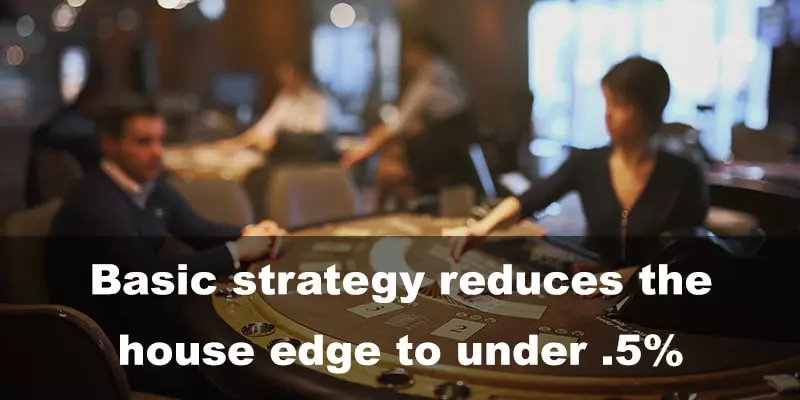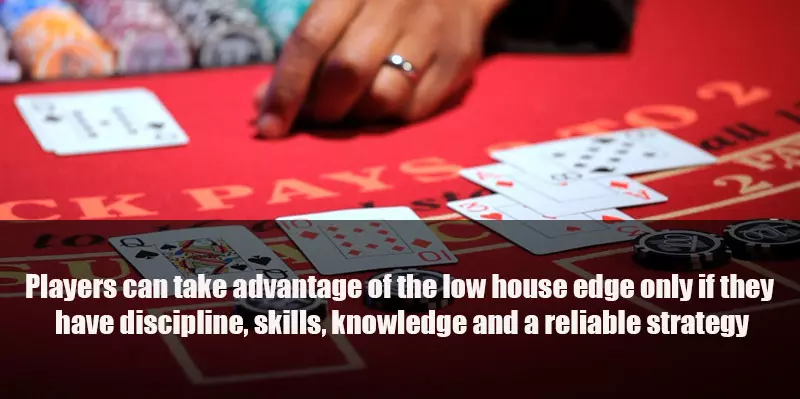Even though many people underestimate it, choosing the right casino is just as important as knowing the rules of Blackjack or having a decent bankroll. The casino is not just a place to go, where players can bet all of their money and leave as winners or losers. They should take into account a number of factors before sitting on the table as they affect their performance directly. Everything in the casino is important – from its setting and layout to the games and bonuses it offers.
When it comes to playing Blackjack, choosing the right casino plays a crucial role and it determines to some extent whether there is an actual possibility to win. As already mentioned in the previous chapter, Blackjack is a game with more than 100 different variations and some of them are even exclusive to particular casinos.
Thus, the game’s rules also vary and players have a better or worse chance of gaining an advantage over the casino. Now is the time to explain how the house edge works in gambling games, where it results from in blackjack, and how blackjack players can reduce it.
What Is House Edge
As it came clear to most of the players the first time they played Blackjack, the casino has a built-in advantage. This shouldn’t be like a bolt from the blue as after all, this is the reason why the casino offers games in the first place. However, what should be taken into account is that the different variations of the game give the players higher or lower chances of winning.
The house edge is a term used in the gambling industry and it shows the mathematical advantage the casino has over the players. This mathematical advantage is inherent to all casino games as the odds of the house winning money in the long term are inevitably higher than those of the players turning a profit.
Some of the main factors that create the casino’s edge are the reductions in the winning wagers’ payouts and the specific game rules laid down by the house. It is usually expressed as a percentage that indicates the casino’s long-term profit on average in relation to the overall amount players have wagered on a given game.
House Edge and Payout Reduction
This advantage is incorporated into every single wager one makes on the casino floor. The casino’s built-in advantage can be calculated by dividing the negative expected value of a wager by the overall amount wagered. The result is then multiplied by 100 to arrive at the house edge as a percentage. The simplest way to show you how this works is by using a coin flip example.

Heads and tails both have equal chances of being tossed with a fair two-sided coin, i.e. 50% for each outcome. When expressed in odds format, this 50% probability corresponds to a 1 to 1 payout, meaning that you should get 1 unit back per every unit wagered in a fair game. Both sides involved in one such betting game would break even over the long term.
Neither party would realize a profit in this instance since the two possible outcomes will eventually even out, with heads and tails occurring the same number of times. Money simply changes hands until eventually, the two parties end up with the same amount they have originally started playing with.
This would not be the case, if one of the parties involved in the game decides to shorten the payouts of winning wagers, paying the other person at odds of 0.9 to 1 for a correct guess rather than at the true odds of 1 to 1.
The mispaid party would end up losing 10 pence per every pound wagered each time they make a correct prediction, or roughly half of the time. An incorrect guess would cause them to lose the entire pound. The wager would yield a negative expected value of £0.10.
This payout shortage would create a house edge equal to HE = (-EV / Wager) x 100 = (-0.10 / 1) x 100 = -0.10 x 100 = -10%. This leads us to the conclusion that the party that mispays at odds of 0.9 to 1 holds a 10% mathematical advantage in this coin-flip game.
The house edge can also be expressed as a decimal number that reflects how much players will lose per wagered unit. The formula is a bit more complex. You multiply the payout for the winning bet by the probability of winning.
Then you multiply the probability of losing by the amount you will lose if the wager is unsuccessful. Finally, you add up the two results to arrive at the game’s house edge per unit wagered.
The House Edge and the Law of Large Numbers
The house edge combines with the law of large numbers to guarantee long-term profits for the casino. We only emphasise this because many players are aware there is a house edge but still fail to understand how exactly it grinds down on their bankrolls.
The casino holds roughly 0.5% (0.005 expressed as a decimal) advantage over blackjack basic strategy players but this does not mean you will lose exactly 50 pence if you wager £100 within several hours.
In reality, the house edge takes thousands of hours of play to manifest itself, a phenomenon known as the law of large numbers. Within several hours, a player with a £100 bankroll will either lose it (partially or in full) or manage to get ahead. Nothing is impossible in the short term where the law of small numbers dominates. Such small samples are by no means representative of what is to happen over the long term, though.
Also important is the fact the casino advantage applies to the overall amount players wager, not to the initial bankroll one sits downs at the table with. Some people argue the average recreational blackjack player would never go through thousands of hours of play to fall victim to the house edge.
While this is true to a certain extent, we should not forget many people are betting simultaneously on the casino floor. A single individual would hardly play thousands of hours of blackjack within their lifetime unless they are a professional.
Nevertheless, there are enough patrons on the floor to generate a couple of thousand hours’ of action within a relatively short time, securing a guaranteed profit for the house. And let’s not forget casinos take wagers from customers seven days a week.
Thus, the house edge guarantees a constant cash flow to the casino coffers. The longer you play and the more hands you go through per hour, the higher the chances of your results matching up with the advantage of the house for the respective game, be it blackjack, roulette, baccarat, and so on. Have you ever wondered why there are no clocks or windows in the casinos? Yes, you guessed correctly – this is to prevent patrons from keeping a track of time.
Also worth mentioning is that the more logic and knowledge a game requires, the better chances players have to win it. As blackjack is a game of skill and probabilities, it has a low house edge, but it also depends on the casino and the particular variation of it.
Blackjack House Edge
Traditional blackjack multi-deck variants have a house edge of under 0.50% on condition one plays with basic strategy. The house edge depends on a variety of things, including the number of decks used in the game. However, the house’s primary advantage results from the fact that players must make decisions on their hands before the dealer plays out theirs. Suppose a player is dealt a 10-6 against the dealer’s a 9-7.

Both of them have a hard 16. The player goes first, draws a 9, and busts with a total of 25. The dealer then plays their hand and also catches a 9 to get a 25. Both the dealer and the player have the same hand total but this is not considered a push. Instead, the player loses their wager because they have exceeded 21 before the dealer did. The dealer loses nothing regardless of the fact they have also busted.
Something similar occurs when all seated players at the table go over 21 before the dealer completes their hand. The dealer will simply reveal their face-down card so that the casino’s surveillance can see it and remove the players’ losing hands from the table. The dealer will not draw additional cards to their hand even if it is under 17.
There is no need to since the players have already lost automatically to the house by busting. This rule alone leads to an initial advantage of 8% for the casino but this percentage is reduced by the implementation of a basic strategy and the bonus payout for natural blackjacks.
What is a Hold Percentage in Blackjack
So far, we thoroughly explained the concept of the house edge. In this section, we would like to pay attention to another important term – a hold percentage. Perhaps, novice blackjack enthusiasts have never heard of this, but it is as important as the house edge itself. While the house edge represents the casino’s built-in advantage over the players, the hold percentage takes into account how much money a given table generates for the house.
By rule, the hold percentage is higher than the house edge. And there is a good reason for that – the house edge assumes that players stick to the basic strategy and their game is flawless. On the other hand, the hold represents a more realistic number as it assumes that even the most knowledgeable blackjack player makes mistakes. In a nutshell, the hold percentage estimates the profitability of the tables.
For instance, you bet a total of £100 on a variation of blackjack that has a 0.5% house edge. Then, the casino is expected to win £0.50 in the long run. However, in reality, you might lose your entire bankroll, which will give the table a 100% hold percentage. The hold percentage takes into account only the net profit derived from a given table. For example, if casino fans playing at a given blackjack table stake a total of £10,000 over a given period and they lose £1,000, then the table’s hold percentage is 10,000/1,000=10%.
Deck Number and the House Edge
As stated earlier, the number of decks also has a direct impact on the advantage the casino holds over blackjack players. One of the reasons for this has to do with the number of hands played before the reshuffle. Since the house has an advantage on every single hand, the more hands patrons go through per hour, the more the casinos will benefit.
When one or two decks are in play, the cards must be reshuffled after one to seven hands, depending on the number of players at the table. This is not the case in blackjack games dealt out of a shoe that contains four to eight full decks. The shoe enables the house to generate over twenty hands before the dealer reshuffles.
Reshuffling the cards slows down the casino’s rate of making money because it causes a pause in the game. Nobody places bets during the reshuffle. Hence, a blackjack dealer who deals out sixty hands each hour generates more profits for the house than a dealer who produces only twenty or thirty hands each hour.

Some casinos have taken this approach even further by using Continuous Shuffling Machines. The discards are loaded into the machine once every couple of rounds. The machine constantly shuffles them, sparing the dealer the hassle and time required for a reshuffle. It is no coincidence that people who consistently play at CSM tables end up losing more money in the long run.
Deck number can also reduce or increase the house edge. As a rule of thumb, the fewer decks a given blackjack game uses, the lower the casino advantage gets. Some players argue that the ratio of the cards remains the same, regardless of whether a game uses one or eight decks.
While this is true, the fact still stands that players will get more blackjacks, successful splits, and advantageous double-down opportunities in single and double-deck games. This is because the effect of any given card’s removal becomes more pronounced the fewer decks are in play. The probability of hitting a blackjack and doubling down successfully drops slightly with each deck added to the game.
Alert readers may point out fewer decks also work to the benefit of the dealer and they would be correct. The dealer will also draw more naturals in single and double-deck variations. They would hit strong totals like 21 more frequently, similarly to players.
However, we should not forget that the dealer would only collect even-money payouts for their blackjacks whereas the player is paid at bonus odds of 3 to 2. The same goes for the player’s successful double downs which return twice the original wager. These higher payouts are what reduces the house edge in blackjack to a tolerable percentage.
Playing Conditions and Their Impact on the House Edge
In blackjack, the house edge is also influenced by playing conditions such as the dealer’s drawing and standing rules, the payouts for blackjacks, the availability of surrender, and the rules regarding splitting and doubling down.
Each rule adds to or takes away from the casino advantage. You should always hunt for tables with player-friendly rules to benefit from low house edges. Casino Guardian lists some of the most favourable conditions below, along with the house edge reductions they cause.
- Doubling down on any first two cards (-0.23%)
- Doubling down after a split (-0.14%)
- Hitting split aces (-0.19%)
- Resplitting aces (-0.08%)
- Late surrender (-0.07%)
- Blackjack bonus payouts of 3 to 2 (-0.32%)
- One deck in play (-0.48%)
- Two decks in play (-0.19%)
- Six decks in play (-0.02%)
- The dealer peeks for blackjacks on tens and aces (-0.11%)
- The dealer stands on soft 17 (-0.22%)
It is very important to check the house edge and the rules established by the casino before playing as these are the things that determine whether players’ positions will be advantageous. When choosing a casino, players should pay special attention to its edge as it is directly connected to their performance and it shows whether the odds work in their favour or not.
Player-Friendly Rules in Blackjack
The house may have an initial advantage but there are several peculiarities of the game that are unavailable to the dealer. Some rules tilt the scales in players’ favour. Unlike the dealer, who receives even money for their winning blackjacks, the player is paid at higher casino odds of 3 to 2. This alone suffices to significantly reduce the house edge in blackjack.
Players can also double their bets when they have favourable starting hands like two-card totals of 10 and 11. The same goes for splitting pairs, an option that is again unavailable to the dealer.
Another beneficial rule allows the player to decline drawing additional cards to hard totals 12 through 16, which stand good chances of busting on the next hit. Meanwhile, the dealer has no other choice but to draw to 16 and stand on 17 since they must always follow the fixed rules of the house.
Common Mistakes
Many people often underestimate the importance of the house edge as they tend to think that it doesn’t play a crucial role. However, this is not the case as when the house edge is low they have much better chances of winning. In the same sense, if the house edge is high, players will lose their money quicker and won’t be able to stay in the game long enough in order to make a profit. This is the reason why Blackjack grew in popularity so much as it offers players a low house edge.
No matter how attempting may Blackjack seem due to its low house edge, players can take advantage of it only on the condition that they have discipline, skills, knowledge, and a reliable strategy. If they go to a casino to play the game and just recklessly wager all of their funds without putting any thought into their actions, the consequence of their moves will be a total loss of their money in no time. The thing with the naive players is that even if they get lucky and win, they do not know when to stop which results in losing their profit and the rest of their bankroll. Without any money management and strictly defined loss limits and win goals, no matter how low the house edge is, players are bound to lose every time.

Importance of the House Edge
People often get discouraged knowing that before they have even started playing, the odds are already against them. However, if players have the right strategy and attitude, this won’t be an obstacle for them. In games that do not require much thought and consideration such as slots or keno, the chances that players will be at a loss are much higher.
The reason for this is simple – they require nothing but luck and players cannot do anything to influence the outcome of the situation and there is no intermediate position – they either lose or win. Blackjack is a game which requires discipline, good strategy, decent bankroll and a number of skills. Even if players choose this game due to the fact it gives them the needed advantage, if they don’t have a plan beforehand, the house edge won’t make any difference.
Blackjack Rules
Blackjack Variations
Blackjack House Edge
Blackjack Odds and Probabilities
Blackjack Soft & Hard Hands
Reducing the House Edge
Blackjack players have every reason to rejoice because unlike other gamblers, they are blessed with a mathematically accurate strategy that could help them further reduce the house edge of the game. The so-called basic blackjack strategy has been refined over the past half a century by numerous mathematicians and gaming experts.
It shows the player the optimal standing, hitting, splitting, doubling, and surrendering decisions for each hand total against any starting card of the dealer. With its help, players can reduce the house edge to 0.50% or less in multiple-deck blackjack, assuming the rest of the playing conditions are also favourable.
Upon examining a basic strategy chart, you will notice that it recommends splitting and doubling predominantly against low upcards of the dealer like 2 through 6. This is because the dealer goes over 21 roughly 40% of the time when they start their hand with low cards. In turn, the player stands higher chances of earning twice as much from doubling and splitting against the weak dealer.
The basic strategy reduces the house edge by helping players maximize their earnings during favourable situations, minimize their losses when at disadvantage, and improve the odds of winning with certain hands.
Without it, the house advantage would be 2% or higher, depending on the rest of the house conditions. Blackjack players can further reduce the casino’s edge by taking advantage of promotional incentives and loyalty points. Advanced players master a technique called card counting that can altogether wipe the house edge out of the equation.
House Edge of Different Variations of the Game
As already mentioned, Blackjack has many different variations which have additional rules and subtleties. They vary depending on the casino and are usually displayed on the table. Players should get familiar with them in advance and also pay special attention to the house edge changes. For instance, the edge of the casino in Super Fun 21 is more than 1% provided that players use the basic strategy. Having in mind that the house edge of the classic Blackjack is less than 1% in most cases this variation of the game works against players.
Some casinos offer Blackjack layouts that have the so-called field bets or in other words, these are side bets. Players need to be especially careful, should they decide to take advantage of them as usually these optional side bets work in favour of the casino. Some variations of Blackjack have a house edge that is determined at the beginning of the game. For instance, Red/Black is such a version as it is played in the following way: players make a bet in accordance with the dealer’s first card. The house edge is nearly 3.8% if this first card in question is a two which matches the colour of the players’ initial bet.
| House Edge of Popular Blackjack variants | |
|---|---|
| Variant | House Edge |
| Atlantic City Blackjack | 0.35% |
| European Blackjack | 0.39% |
| Multi-Hand Blackjack | 0.63% |
| Double Exposure Blackjack | 0.69% |
| Single Deck Blackjack | 0.58% |
| Blackjack Switch | 0.17% |
| Super Fun 21 | 1.30% |
| Pontoon | 0.39% |
| Perfect Pairs Blackjack | 0.42% |
| Spanish 21 | 0.38% |
Conclusion
These are only a few examples of how the course of the game changes when the house edge is different. This is the reason why prior to entering the game, players should make sure that they are familiar with the rules and the house edge as this might make the difference between winning and losing. The house edge is one of the most important things players should consider as after all this determines their chances of gaining an advantage over the casino.